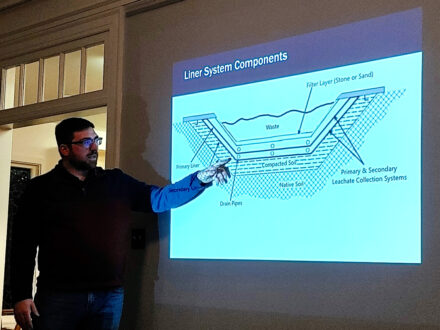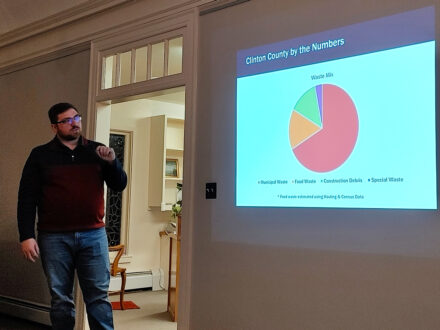Radioactive material in our waste! Just one of the surprising facts revealed at Community Learning Series presentation

Presenter Sean Lukas, Peru resident and General Manager of Clinton County’s Solid Waste and Recycling Facility

By Marque Moffett
Perhaps it sounds strange to purposely leave one’s house on a Monday evening to go sit in a folding chair at the library and learn about garbage. But that is exactly what about a dozen people chose to do. By all accounts, they were very glad they did!
On Monday, Feb 27th, attendees of the second Community Learning Series event were treated to a presentation about our local landfill and recycling services that was chock-full of surprising and interesting information.
Presenter Sean Lukas, Peru resident and General Manager of Clinton County’s Solid Waste and Recycling Facility, moved quickly through some logistical information and jumped into a story about a radioactive signal on a garbage truck.
The landfill has a very specific list of materials it cannot accept. Included on that list are radioactive materials. If upon hearing this, you’re wondering why locals would be disposing of Back to the Future-style briefcases full of plutonium, you are not alone. However, the radioactive materials that make their way to our landfill are much more benign. Typically, they are either adult diapers used by individuals undergoing certain types of chemotherapy or, less often, some types of local rock.
As trucks haul garbage to our Sand Road facility, they are screened for radioactivity. Each time the detector, which is extremely sensitive, goes off, Sean or another employee must climb into the truck with a hand-held detector to locate the radioactive material. Quite the job!
Beyond entertaining stories such as radioactivity in garbage trucks, Sean also shared some very interesting information about how our recycling is handled. Roughly 11,000 tons of locally-collected recyclable materials are trucked to Casella’s Materials Recovery Facility in Rutland.
That whopping amount of materials are sorted by human effort and some very impressive technology, including computerized optical sorters for plastics and reverse magnetic polarity for collecting aluminum products. Interested parties can learn more by watching the video Sean shared during his presentation: https://www.youtube.com/watch?v=NOHlPfI3c90.
Continuing with the thread of impressive technologies, Sean easily convinced everyone in attendance that modern landfills are not merely dumps. Landfills, called “dry tombs” by some, are engineered to keep all waste materials contained. This includes rainwater that falls into the landfill and moves through our garbage.
The liquid from a landfill is called leachate; you can imagine how gross it would be. Luckily, multiple layers of protective barrier keep leachate and debris from escaping into the environment. Each day, roughly 9000 gallons of leachate are collected from the landfill and transported to the City of Plattsburgh’s Wastewater Treatment Facility.
The landfill also collects methane and other gases generated by organic materials, such as food waste. In addition to being foul-smelling, methane is a serious contributor to climate change. The landfill has created an extensive network of piping that collects gases before they escape into the environment and directs them to the on-site energy plant. There, the methane is combusted by 20-cylinder engines that convert waste gas into electricity, enough to power ~5000 homes per year. Isn’t that something?!
February’s Community Learning Series was another excellent opportunity to learn more about how things work here at home. The Community Learning Series is organized by the Peru Democratic Committee and is free and open to all, regardless of voter registration and town residence.
Posted: March 8th, 2023 under Business News, Community Events, Environmental News, General News, Northern NY News, Peru Library News, Peru News.
